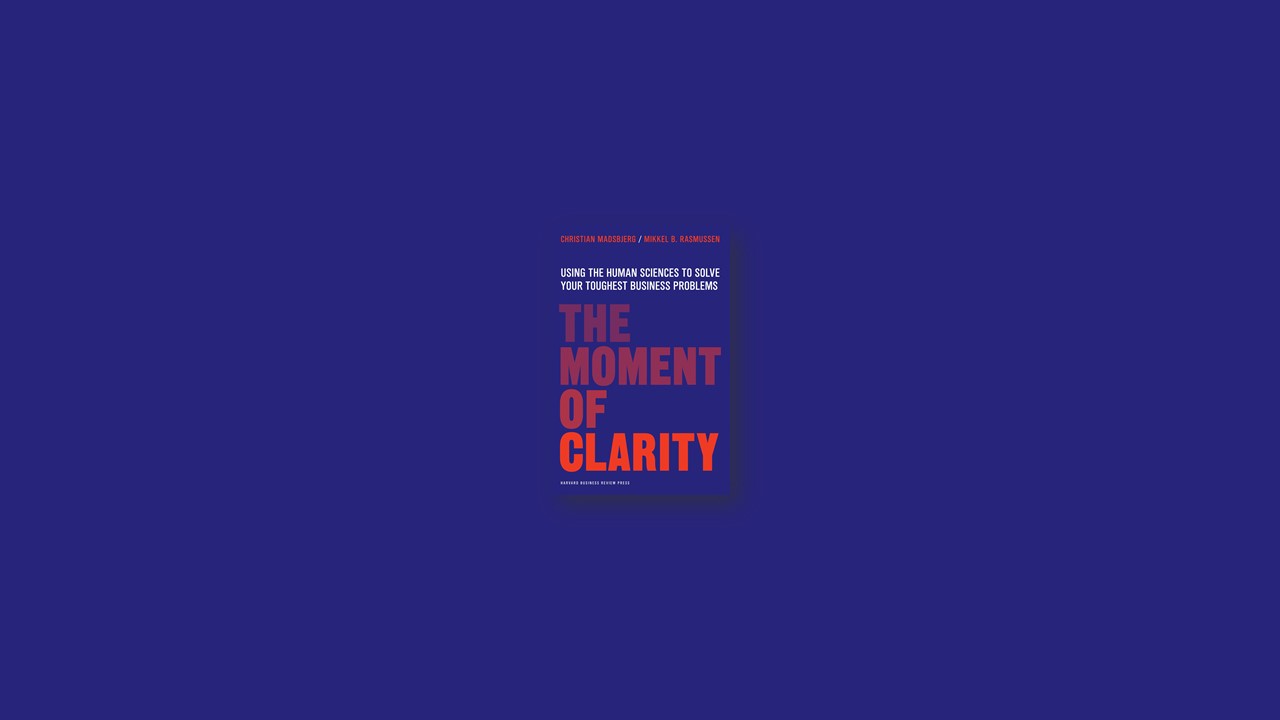How to Lead to Your Moment of Clarity
Leaders are often portrayed as decision makers: they sit on top of the hierarchy and make choices about the company’s strategy in light of recommendations provided by the staff. When all of the facts are in, the decision maker weighs his or her options and then announces a decision. A decision makers’ job is to steer the company through good times and rough times. They set the direction and vision for the entire company: they define the values and principles, set the strategic goals and priorities, and surround themselves with a team that is accountable for executing vision and strategy. But each of these tasks is fundamentally seen as a kind of decision. You decide what the vision of the company should be and what strategic priorities need to be taken. Leadership as decision making is almost seen as a kind of science or technique in itself. There is one right way to lead more effectively.
The role of the leader as a decision maker is perfectly in line with the default problem-solving model in business: hypothesis driven, quantitative, and linear. The decision maker role works well when there is a well-established relationship between cause and effect and between problem and solution. It is a highly efficient way to utilize leadership capability. The executive can distance himself or herself from the everyday operation of the business, make a vast set of decisions quickly, and trust that if the business does x, it can expect y.
Sensemaking requires a different type of leadership skill. Whereas a decision maker analyzes, a sensemaker creates. The sensemaker’s job is to find new ways to compete for the business; it is about looking ahead and seeing what’s next, defining new spaces to compete in, giving new meaning to the offerings of the company, and putting words to something that may not be entirely understood yet.
Leading by way of sensemaking requires that you, as a leader, know how to ask the right questions, how to see the patterns in the data, how to make the right interpretation, and how to shape those interpretations into actions. Hiring human-science researchers or experimenting with open-ended qualitative studies will not create much impact without your direction and interpretation into the particulars of your company. And insights will be of little value if you can’t put them into action.
The Three Skills of a Sensemaking Leader
Unlike the frameworks in most management theory, the leadership skills you need at the helm of a method like sensemaking cannot be learned in a business school, an executive program, or business books. It is not a technical skill; it is a practical skill that you learn through experience. Just as you can’t learn to be a good football player without playing, a good carpenter without carpentering, or a good writer without writing, the good leader is forced to use experience, judgment, and wisdom.
Having said that, we have observed three fundamental characteristics of great sensemaking leadership:
- Sensemakers care deeply about the products and services they make and the meaning that these offerings create for people.
- Sensemakers have a strong perspective on their business—a perspective that stretches beyond the current time horizon and the current company boundaries.
- Sensemakers are good at connecting different worlds inside the company. An organization should have a diverse set of skills to understand the big idea, translate it into action, and maintain the operation.
Leading with Care
If you are in the beauty business, you simply can’t make sense of deep insights on beauty ideals if you don’t care about the meaning of beauty products. If you are in the car industry, you have to care about cars and transportation—otherwise, the human phenomenon of driving does not make sense at all. Without care, you will see everything as properties, or what Isaiah Berlin called “so many individual butterflies.”
Care is such a fundamental human condition that it is noticeable in an instant—as is its absence! When you walk into an IKEA store, you know instantly that someone cares about making contemporary design furniture available for people at low prices. You see evidence of care in both senses of the word, in terms of mattering and carefulness: in the meticulous organization of the store, it is evident that the creators of the store were deeply invested in its mission. You can see it in the way the store has been designed—it is not the nicest store in the world, but it does its job incredibly well. You are led through IKEA much as you would be led through a museum of interior design. The products are shown in their context, so that a whole kitchen looks like it would look in your home; it’s not just a bunch of individual cupboards, tables, and chairs. You can see it in the products; they fit nicely into most homes, and someone has taken the utmost care in design to get them down in price without sacrificing too much on the aesthetic side. You can see it in small details like the names of the products. For the most part, all items are named according to a system developed by IKEA where each type of item carries a different name origin.
You can find care everywhere. You can find it in your local grocery store, in your city library, in kindergartens, in sushi restaurants, in computer games, and even in the way the sewage system works. In places with care, you can just sense that the people working there are deeply involved in what they do; it matters to them.
Leading with Perspective
It can feel a little too obvious to mention Steve Jobs as a great business leader, but he is a good example of a leader who had perspective. In Walter Isaacson’s best-selling biography, Jobs describes his perspective on technology this way: “I always thought of myself as a humanities person as a kid, but I liked electronics. Then I read something that one of my heroes, Edwin Land of Polaroid, said about the importance of people who could stand at the intersection of humanities and sciences, and I decided that’s what I wanted to do.”
The idea of standing at the intersection of technology and humanities is a very original concept of how technology should be designed and what it should do for its users. It is not self-explanatory, as is a statement like “We want to make computers that are easy to use.” Rather, the idea of an intersection is a metaphor for an entirely new way to think about technology.
Interestingly, Jobs’s perspective on technology wasn’t something he jammed up in a brainstorming session; neither was it a calculated business plan he deducted from analyzing the market. Being at the intersection of humanities and technology was a perspective he had thought about for a long time, something that he could sense was missing and something he wanted to see happen. So in addition to functioning as a powerful tool for narrating his company’s mission, the intersection perspective also informed the company’s activities and decisions.
You can find businesses with a strong perspective everywhere and in all shapes and sizes. General Electric, for example, has a strong perspective on using the company’s creative resources to solve the world’s environmental problems, a point of view it calls “ecomagination.” The pharmaceutical company Novo Nordisk has a perspective on diabetes: “Changing Diabetes” aims to break the curve of the diabetes pandemic. Novo Nordisk uses this challenge to guide its investment in R&D and to develop better diabetes support, education, and self-management. It also uses its perspective to engage policy makers, patient organizations, and experts to drive diabetes awareness and prevention. Starbucks has fueled its global expansion with a strong perspective on coffee culture and the coffee shop as a “third place”—your home is the first place, your work is the second place, and Starbucks is the third place. A local soccer club in Copenhagen tells every visitor about its perspective on the game. A sign in the entrance of the club states MAKES BOYS INTO MEN AND MEN INTO BOYS. As you might guess, this club does not offer training for females. The Canadian prison system changed the very idea of what a prison is when the management developed its perspective on prison: “The prisoner shall not return.” The perspective shifted the implicit metaphor from prison as a place for retention to prison as an educational institute
Connecting Different Worlds
Getting people across the organization to look in the same direction is easier said than done. We sometimes talk about companies as though they were a person with one common mind. But in reality, companies often consist of many different worlds and subcultures with different agendas, different cultural codes, and different metrics of success involving different career paths, different power structures, and different languages. A major challenge for the sensemaker is how to get these worlds to look in the same direction.
As a sensemaker, you need to connect worlds: to draw the eye of the entire organization toward the same star in the sky. That means getting divergent groups on the same page on why, how, and where the company needs to innovate and doing so in a way that motivates people, energizes the teams, and leaves lots of initiative to the organization.
This is not just a matter of getting the message across through a new series of commands from on high. Rather, successful sensemakers look at leadership as a conversation where people are encouraged to participate in the interpretation of what it all means and how anyone can put it into action. Sometimes it can even be a good idea to ask different parts of the organization to participate together in the discovery process before any conclusions are drawn.
At Intel, company leaders have divided their strategy process into three distinct parts: sensing, interpretation, and action. To make the organization look in the same direction, teams of key people from marketing, R&D, and operations work to create a shared understanding of each of these three parts:
- Sensing: Do we share the same insights?
- Interpretation: Are we making the same interpretation of what it means?
- Action: Do we agree on what actions we will take?
Treating a method like sensemaking as an organizational conversation as opposed to a command from on high has a number of advantages: it creates a high level of trust, it builds ownership in the organization, and it speeds up the time from insight to action. The conversation does not necessarily have to be tightly structured like a change management project. In fact, in many of the most successful companies we know, the conversation is often more loosely organized and takes place in many forums over a set period. Think of the way you marinate meat over several hours to make it tender and full of flavor: the conversation needs to simmer.
Of course, the conversation can’t go on forever. Once the direction is set and everybody is on board, the sensemaker needs to shift focus from talking to acting. Now the job of leadership is to keep everyone on track and to avoid the distractions of mythical silver bullet solutions.


